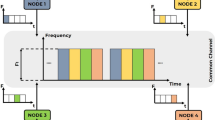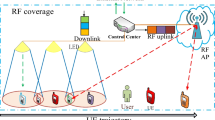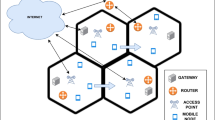Abstract
The admission control is required to maintain the established route between the source and the destination in the wireless network. To maintain the stability of the route, the wireless channel parameters has to be adopted appropriately. Thus, this study analyzes the wireless access medium parameter through direct coordination (DCF) and point-to-point coordination method. The packets are fragmented in DCF and contention free period interval are adjusted to study the QoS parameters for various VOIP codec using OPNET simulation tool. The result shows that packet fragmentation to 256 bytes and contention free period for 20 ms improves QoS for G.729 for Voice traffic.











Similar content being viewed by others
References
Alsahlany A (2014) Performance analysis of VOIP traffic over integrating wireless LAN and WAN using different codecs. Int J Wirel Mobile Netw (IJWMN) 6(3):79–89
Anand GCS, Vaidya RR, Velmurugan T (2011) Performance analysis of VoIP traffic using various protocols and throughput enhancement in WLANs. In: International conference on computer, communication and electrical technology (ICCCET 2011) pp 176–180
Anouari T, Haqiq A (2012) Performance analysis of VoIP traffic in WiMAX using various service classes. Int J Comput Appl 52(20):29–34
Jung Y, Manzano C (2014) Burst packet loss and enhanced packet loss-based quality model for mobile voice-over Internet protocol applications. IET Commun 8(1):41–49
Lakas A (2007) Experimental analysis of VoIP over wireless: local area networks. J Commun 2–4:3–9
Mohammed HA, Ali AH, Mohammed HJ (2013) The affects of different queuing algorithms within the router on QoS VoIP application using OPNET. Int J Comput Netw Commun (IJCNC) 5(1):117–124
Neupane K, Kulgachev V, Elam A, Vasireddy SH, Jasani H (2011) Measuring the performance of VoIP over wireless LAN. In: Goda B, Sobiesk E, Connolly R (eds) SIGITE’11 Proceedings of the 2011 conference on information technology education. ACM, New York, pp 269–274
Siddique MAR, Kamruzzaman J, Hossain MJ (2014) An analytical approach for voice capacity estimation over WiFi network using ITU-T E-model. IEEE Trans Multimed 16(2):360–372
Acknowledgments
The authors thank the UK-India Education and Research Initiative (UKIERI) for sponsoring this research project (UGC-2013-14/037) between Anglia Ruskin University in UK and the ABV-Indian Institute of Information Technology and Management in India for 2 years.
Author information
Authors and Affiliations
Corresponding author
Rights and permissions
About this article
Cite this article
Fakrudeen, M., Yousef, S., Tapaswi, S. et al. Voice performance analysis using voice codec by packet fragmentation and contention free periods in wireless networks. Int J Syst Assur Eng Manag 8 (Suppl 2), 758–764 (2017). https://doi.org/10.1007/s13198-016-0517-0
Received:
Published:
Issue Date:
DOI: https://doi.org/10.1007/s13198-016-0517-0




